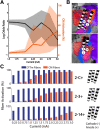Selective activation of central thalamic fiber pathway facilitates behavioral performance in healthy non-human primates
- PMID: 34845232
- PMCID: PMC8630225
- DOI: 10.1038/s41598-021-02270-7
Selective activation of central thalamic fiber pathway facilitates behavioral performance in healthy non-human primates
Abstract
Central thalamic deep brain stimulation (CT-DBS) is an investigational therapy to treat enduring cognitive dysfunctions in structurally brain injured (SBI) patients. However, the mechanisms of CT-DBS that promote restoration of cognitive functions are unknown, and the heterogeneous etiology and recovery profiles of SBI patients contribute to variable outcomes when using conventional DBS strategies,which may result in off-target effects due to activation of multiple pathways. To disambiguate the effects of stimulation of two adjacent thalamic pathways, we modeled and experimentally compared conventional and novel 'field-shaping' methods of CT-DBS within the central thalamus of healthy non-human primates (NHP) as they performed visuomotor tasks. We show that selective activation of the medial dorsal thalamic tegmental tract (DTTm), but not of the adjacent centromedian-parafascicularis (CM-Pf) pathway, results in robust behavioral facilitation. Our predictive modeling approach in healthy NHPs directly informs ongoing and future clinical investigations of conventional and novel methods of CT-DBS for treating cognitive dysfunctions in SBI patients, for whom no therapy currently exists.
© 2021. The Author(s).
Conflict of interest statement
J.B, A.B, C.B and K.P have applied for a patent based on these results.
Figures






Similar articles
-
Robust modulation of arousal regulation, performance, and frontostriatal activity through central thalamic deep brain stimulation in healthy nonhuman primates.J Neurophysiol. 2016 Nov 1;116(5):2383-2404. doi: 10.1152/jn.01129.2015. Epub 2016 Aug 31. J Neurophysiol. 2016. PMID: 27582298 Free PMC article.
-
Central thalamic deep brain stimulation to promote recovery from chronic posttraumatic minimally conscious state: challenges and opportunities.Neuromodulation. 2012 Jul;15(4):339-49. doi: 10.1111/j.1525-1403.2012.00458.x. Epub 2012 May 24. Neuromodulation. 2012. PMID: 22624587 Review.
-
Central Thalamic Deep-Brain Stimulation Alters Striatal-Thalamic Connectivity in Cognitive Neural Behavior.Front Neural Circuits. 2016 Jan 13;9:87. doi: 10.3389/fncir.2015.00087. eCollection 2015. Front Neural Circuits. 2016. PMID: 26793069 Free PMC article.
-
Central thalamic deep brain stimulation for cognitive neuromodulation - a review of proposed mechanisms and investigational studies.Eur J Neurosci. 2010 Oct;32(7):1135-44. doi: 10.1111/j.1460-9568.2010.07420.x. Eur J Neurosci. 2010. PMID: 21039953 Free PMC article. Review.
-
Centromedian-parafascicular deep brain stimulation induces differential functional inhibition of the motor, associative, and limbic circuits in large animals.Biol Psychiatry. 2013 Dec 15;74(12):917-926. doi: 10.1016/j.biopsych.2013.06.024. Epub 2013 Aug 30. Biol Psychiatry. 2013. PMID: 23993641 Free PMC article.
Cited by
-
Thalamic deep brain stimulation in traumatic brain injury: a phase 1, randomized feasibility study.Nat Med. 2023 Dec;29(12):3162-3174. doi: 10.1038/s41591-023-02638-4. Epub 2023 Dec 4. Nat Med. 2023. PMID: 38049620 Free PMC article. Clinical Trial.
-
Electrical rejuvenation of chronically implanted macroelectrodes in nonhuman primates.J Neural Eng. 2024 Jun 27;21(3):10.1088/1741-2552/ad5703. doi: 10.1088/1741-2552/ad5703. J Neural Eng. 2024. PMID: 38862007 Free PMC article.
-
A human brain network linked to restoration of consciousness after deep brain stimulation.medRxiv [Preprint]. 2024 Oct 18:2024.10.17.24314458. doi: 10.1101/2024.10.17.24314458. medRxiv. 2024. Update in: Nat Commun. 2025 Jul 21;16(1):6721. doi: 10.1038/s41467-025-61988-4. PMID: 39484242 Free PMC article. Updated. Preprint.
-
Deep brain stimulation in disorders of consciousness: 10 years of a single center experience.Sci Rep. 2023 Nov 9;13(1):19491. doi: 10.1038/s41598-023-46300-y. Sci Rep. 2023. PMID: 37945710 Free PMC article.
-
Toward an interventional science of recovery after coma.Neuron. 2024 May 15;112(10):1595-1610. doi: 10.1016/j.neuron.2024.04.027. Neuron. 2024. PMID: 38754372 Free PMC article. Review.
References
-
- Schiff ND. Central thalamic contributions to arousal regulation and neurological disorders of consciousness. Ann. N. Y. Acad. Sci. 2008;1129:105–118. - PubMed
-
- Stierwalt JAG, Murray LL. Attention impairment following traumatic brain injury. Semin. Speech Lang. 2002;23:129–138. - PubMed
-
- Stuss DT. Traumatic brain injury. Curr. Opin. Neurol. 2011;24:584–589. - PubMed
-
- Dikmen SS, Machamer JE, Powell JM, Temkin NR. Outcome 3 to 5 years after moderate to severe traumatic brain injury. Arch. Phys. Med. Rehabil. 2003;84:1449–1457. - PubMed
Publication types
MeSH terms
Grants and funding
LinkOut - more resources
Full Text Sources
Medical

